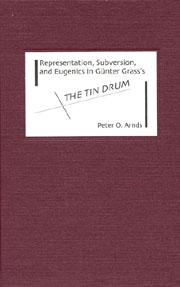Book contents
- Frontmatter
- Contents
- Acknowledgments
- Abbreviations
- Introduction
- 1 Representing Euthanasia; Reclaiming Popular Culture
- 2 Heteroglossia from Grimmelshausen to the Grimm Brothers
- 3 The Dwarf and Nazi Body Politics
- 4 Oskar's Dysfunctional Family and Gender Politics
- 5 Oskar as Fool, Harlequin, and Trickster, and the Politics of Sanity
- 6 Gypsies, the Picaresque Novel, and the Politics of Social Integration
- Epilogue: Beyond Die Blechtrommel: Germans as Victims in Im Krebsgang
- Works Cited
- Index
Epilogue: Beyond Die Blechtrommel: Germans as Victims in Im Krebsgang
Published online by Cambridge University Press: 05 February 2013
- Frontmatter
- Contents
- Acknowledgments
- Abbreviations
- Introduction
- 1 Representing Euthanasia; Reclaiming Popular Culture
- 2 Heteroglossia from Grimmelshausen to the Grimm Brothers
- 3 The Dwarf and Nazi Body Politics
- 4 Oskar's Dysfunctional Family and Gender Politics
- 5 Oskar as Fool, Harlequin, and Trickster, and the Politics of Sanity
- 6 Gypsies, the Picaresque Novel, and the Politics of Social Integration
- Epilogue: Beyond Die Blechtrommel: Germans as Victims in Im Krebsgang
- Works Cited
- Index
Summary
This study has focused on the victims of Nazi biopolitics, primarily the physically and mentally disabled targeted by the euthanasia program. In a discussion of Oskar Matzerath as a folklore dwarf and of fairy tale motifs as a vehicle for historical representation, it ought to be pointed out that Oskar is a hunchback dwarf also in the Benjaminian sense. Walter Benjamin (1892–1940) used this metaphor of the little hunchback (das bucklicht Männlein) throughout his work. Hannah Arendt even suggested that Benjamin's whole life could be placed under the sign of the hunchback dwarf. She contends that just before his death Benjamin stated that the little hunchback had terrified him in his early childhood and then accompanied him all through his life. Benjamin was familiar with this fairy tale figure from Des Knaben Wunderhorn (1805–8), the famous anthology of German folk poems collected by Achim von Arnim (1781–1831) and Clemens Brentano (1778–1842), particularly from Brentano's folk rhyme “Liebes Kindlein, ach ich bitt, Bet fürs bucklicht Männlein mit” (O dear child, I beg of you, pray for the little hunchback too). In his fascinating study of Benjamin's hunchback Irving Wohlfahrt argues that Brentano's “plea for inclusion implicitly becomes that of all the excluded.” Yet Benjamin was thinking primarily of the plight of Jews under German fascism when he wrote of the hunchback, a figure that has all the characteristics of the trickster discussed in chapter 5 of this study.
- Type
- Chapter
- Information
- Publisher: Boydell & BrewerPrint publication year: 2004



